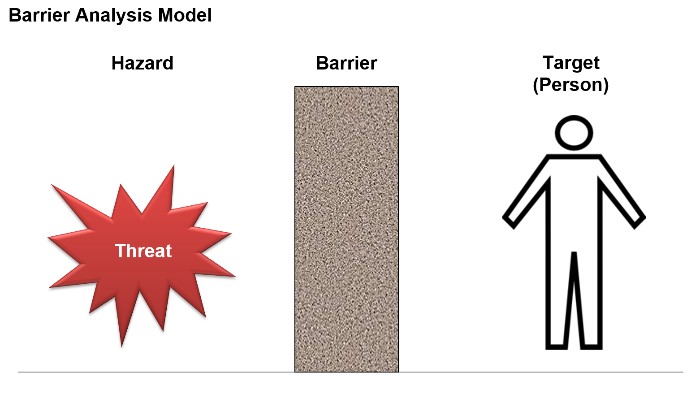Barrier analysis is a model used by some organizations to understand both why a problem happened and how it can be prevented. It’s primarily applied to safety incidents, but can be used for other issues as well. The premise of a barrier analysis is that a problem is prevented by having barriers in place to control hazards.
Barrier Analysis is also called Target-Hazard-Barrier analysis. The U.S. Department of Energy (DOE) uses the term Hazard and Barrier Analysis. The DOE created a 122-page guidance document in 1996 that explains their approach to Hazard and Barrier analysis. Get a copy here.
There are three basic elements in barrier analysis: the target, the hazard and the barrier. The target is usually a person performing a job. The goal for personnel safety is zero injuries. The target in the analysis is the person to be protected.

The hazard is a way in which the target can be harmed. Hazards are identified for different activities. Examples of hazards include elevated work, electricity or rotating parts. A hazard is also called a threat to the target. The department of energy document includes a list of 72 different hazards organized in 15 categories.
Barriers provide control over the hazard by preventing it from reaching the target. A barrier may be physical, procedural or individual actions that people take. The term control is used in other problem-solving methods such as process hazard analysis (PHA). Barriers and controls can be used interchangeably and both prevent unwanted effects. A single barrier provides one layer of protection for the target.
Protecting Pedestrians with a Barrier
These people are running over the bridge with a protective barricade between them and the road. In this example, the target is the people on the sidewalk. The hazard is the vehicles traveling down the road. The barrier is the actual wall that prevents the vehicles from contacting the runners.

Notice the difference between the two barriers above. The concrete barrier provides a solid wall that can absorb significant impact from a vehicle. The portable barriers can separate the pedestrians from the cars, but they provide no protection from a vehicle. They’ll be knocked out of the way. Not all barriers are equally effective. The design of the barrier and its reliability need to be considered in the selection process.
Holes in the Barrier
When a barrier fails, the hazard reaches the target. This is commonly referred to as a hole in the barrier. There are weaker barriers and stronger barriers - type and design can vary. The effectiveness and reliability of a barrier is analogous to selecting solutions to prevent a problem. The barriers currently in place within organizations are solutions from previous incidents. The defined standards and industry best practices also originated from previous incidents – some of which may have occurred long ago. Problems within an organization yield lessons, which provide insight for better practices going forward. It’s an ongoing cycle.
Swiss Cheese is Multiple Barriers
In some cases, more than one barrier is used. This is referred to as adding a layer of protection. Each additional barrier provides another layer to defend against failure. In the case of two barriers, both barriers will have to fail for the hazard to reach the target. Installing multiple barriers is sometimes referred to as defense in depth. Multiple barriers, each with a potential risk of failure (holes) is the origin of the swiss cheese model. The swiss cheese accident model was first developed by James Reason and Dante Orlandella from the University of Manchester. The swiss cheese model is a barrier analysis with multiple barriers – each represented by a slice of swiss cheese. See our explanation of the swiss cheese model.
Accident Models
Creating an accident model, such as a barrier analysis, provides an interesting way to explain the different elements of an incident with defined labels. One of the obligations of using an accident model is the incident must fit within the model. A different approach is to use the incident as the model. Instead of forcing the incident to fit into a predefined scheme, let the details from the specific incident guide the investigation. The cause-and-effect relationships within the incident reveal precisely how all the pieces fit together. An accident model doesn’t dictate the connections, the evidence does.
A barrier prevents effects from occurring. How that barrier prevents those effects is explained by specific cause-and-effect relationships. Cause-and-effect explains barrier analysis - not the other way around. Accident models are helpful for providing a metaphor for an incident. But incidents are explained by cause-and-effect relationships validated with evidence.











